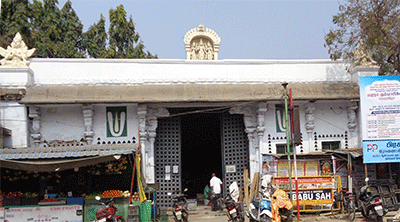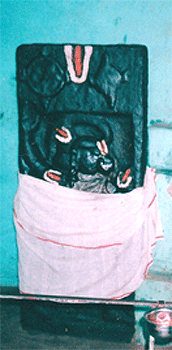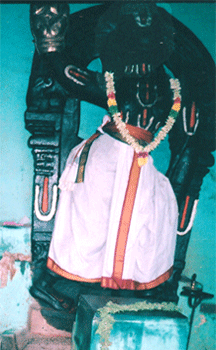
Sri Varadharaja Swami temple
Sri Varadharaja Swami temple is one of the Divya Desam in the city of Kanchipuram, Tamilnadu. This temple along with Ekambareswarar Temple and Kamakshi Amman Temple in Kanchipuram is popularly known as Mumurtivasam (abode of trio). Sri Varadharaja Swami temple is one of the main temples that every Vishnu devotee would like to visit during his lifetime. The temple is also known for the ‘Athi Varadhar’ the deity replica of Sri Varadharaja Swamy carved in fig wood, which is taken out of the temple tank every forty years for forty-eight days and worshiped.
The temple had received the patronisation of all dynasties. Many kings of various dynasties like Chola, Pandya, Kandavarayas, Cheras, Kakatiya, Sambuvaraya, Hoysala, and Vijayanagara had made many contributions and donations to the temple during their time.
The temple is very huge in area and has many sannidhis for various deities. Many scenes from Srimath Ramayanam and Mahabaratham had been depicted in mandapams and walls of the sannidhis enhancing the beauty of the temple.
The annual festival of the temple
 The temple is also famous for the Brahmotsavam conducted during the Tamil month of Vaigasi [May/June]. The devotees participate in this festival which is celebrated with enchantment and gaiety. During this ten-day festival, the processional deity is taken out in different directions on different vehicles, known as vahanam. Sri Perumal is taken out in Hamsa vahanam, Suryaprabai, Hanumath vahanam, Sesha vahanam, Chandraprabai, Golden palanquin, Yali vahanam, Golden chariot, Elephant vahanam, Thotithirumanjam, Horse vahanam, Aalmel palanquin and the great Car on the designated days. And during these festival days, huge umbrellas are used when the Lord is taken out in procession.
The temple is also famous for the Brahmotsavam conducted during the Tamil month of Vaigasi [May/June]. The devotees participate in this festival which is celebrated with enchantment and gaiety. During this ten-day festival, the processional deity is taken out in different directions on different vehicles, known as vahanam. Sri Perumal is taken out in Hamsa vahanam, Suryaprabai, Hanumath vahanam, Sesha vahanam, Chandraprabai, Golden palanquin, Yali vahanam, Golden chariot, Elephant vahanam, Thotithirumanjam, Horse vahanam, Aalmel palanquin and the great Car on the designated days. And during these festival days, huge umbrellas are used when the Lord is taken out in procession.
Aalmel pallakku
On the ninth day of the Brahmotsavam of Sri Varadaraja Perumal Temple, Sri Perarulalan [The processional deity is named thus] is taken out in Aalmel Pallakku [palanquin]. The palanquin gets the name ' Aalmel pallakku ' since the palanquin has been designed as if the palanquin itself is being carried by four people.
On this day the Lord comes out in procession in Aalmel pallakku from the temple in the morning and visits Gangai Kondan mandapam near Sri Shankara Mutt. At Gangai Kondan mandapam, Lord accepts Poochatru sevai . He returns to the temple for Theeerthavari at Anantha Saras. Lord's visit to Gangai Kondan mandapam is a spectacular event since Lord is visiting Kanchipuram from Vishnu Kanchi.
Gangai Kondan mandapam
Rajendra Chozan son of Great Rajaraja Chozan went out on an expedition to expand his kingdom. In 1019 CE, his forces marched through Kalinga towards the river Ganga. In Kalinga, the Chola forces defeated Indraratha the ruler of the Somavamsi Dynasty. Rajendra Chola took the help of the Paramaras and the Kalachuris with whom Indraratha had a bitter enmity and Rajendra Chola took advantage of this situation. The combined armies of Rajendra Chola could defeat Indraratha. He brought water from the River Ganga to the south for the Shiva temple that he was planning to build. Thus he is also known as Gangai Konda Cholan.
 The Ganga water thus brought from there was kept in sanctified places on the way. mandapam was built at a chosen place and after sanctification, the holy water was kept there before moving further. Such mandapams built to keep the holy water by the king were named ‘Gangaikondan mandapam’. Locally it is called ‘ Gangana mandapam’. After the movement of Ganga water from such mandapam, the place was put to use under the local temple, to keep the sanctity of the place intact.
The Ganga water thus brought from there was kept in sanctified places on the way. mandapam was built at a chosen place and after sanctification, the holy water was kept there before moving further. Such mandapams built to keep the holy water by the king were named ‘Gangaikondan mandapam’. Locally it is called ‘ Gangana mandapam’. After the movement of Ganga water from such mandapam, the place was put to use under the local temple, to keep the sanctity of the place intact.
One such Gangaikondan mandapam in Kanchipuram is located just opposite Sri Shankara Mutt.
Gangaikonda mandapam
The Gangaikonda mandapam is located on the southeast corner of Mangala Teertham and just opposite the Sri Kamakoti Sri Shankara Mutt in Big Kanchipuram. The mandapam has highly decorative and ornamentally carved sixteen pillars. From the architect of the pillars, it is assumed that the mandapam had been redone during the Vijayanagara period. As Lord Sri Varadaraja visits this place only during the festivals, the mandapam is put to use by the artisans who are skilled in preparing umbrellas for the festival of the temple. These artisans traditionally making the umbrella for the temple festivals use this mandapam as their workspace. Today it is a heritage building, housing a deity of Sri Hanuman and used as work space for artisans who work on the Temple umbrellas and flower vendors.
Rajendra Chozan had brought water from the River Ganga to the south for the Shiva temple he planned to build. The Ganga water thus brought from there was kept in sanctified places on the way. mandapam was built at a chosen place, and after sanctification, the holy water was kept there before moving further. Such mandapams built to keep the holy water by the king were named ‘ Gangaikondan mandapam’.
Twin Hanuman idols in the mandapam
Two idols of Sri Hanuman are housed adjacent to the northern wall in the center of the mandapam. One can have a darshan of the Lord right from the front door.
The first idol on the left is an embossed type known as the ardha shila type whereas the second on the right is a fully carved type and huge. The style of carving and pose of the Lord taken for worship makes it clear that both idols are of the Vijayanagara period. The smaller idol older of the two could be from the Madhva School of worship and the second one could be from the school of Nayak’s period.
Sanctity of the mandapam
 This place has a unique place in the belief that the sanctity of the place. This had been vouched for by many great saints, in recent times Sri Seshadri Swamigal and Sri Mahaperiyava of Kanchi Kamakoti mutt by visiting this mandapam regularly.
This place has a unique place in the belief that the sanctity of the place. This had been vouched for by many great saints, in recent times Sri Seshadri Swamigal and Sri Mahaperiyava of Kanchi Kamakoti mutt by visiting this mandapam regularly.
Sri Hanuman I
The idol is made of granite in ardha shila type is around five feet tall and facing south. Deity is seen facing east. On both feet, He is wearing nupur and thandai. He is wearing dhothi in kacham style which is held onto His hip with a decorative waist belt. His left hand is holding the sowganthika flower, which is seen near His shoulder. His bosom is adorned with two malas; His right hand is raised and shows abhaya mudra and blessing devotees. His face expresses compassion through his glowing eyes. His long ears are adorning kundalam . His tail is seen just above the head. The disc and conch [ chakra and sanku ] are shown above the deity.
Sri Hanuman II
The idol is made of granite and about seven and a half feet which is kept on a raised platform adjacent to the first idol. The idol is facing south, and the Deity is seen facing the devotees directly. The idol is seen with thruvachi [decorative arch behind the deity – known as prabhai in Sanskrit] made of the same stone. This style of making the deity with prabhai in the same stone is the unique art style of Vijayanagara Nayaks.
The description of the Lord is the same as Sri Hanuman I, except that here Lord is seen giving darshan to the devotee and blesses the devotee with direct ‘kataksham’.
Location of the temple: "Hanuman temple, Gangaikondan Mandpam, Kanchipuram"
Experience
The place sanctified by Ganga water is kept sanctified by the Lords of this kshetra. Darshan of these two Lords at the same place is sure to take away the ill feelings we may carry, and sanctify our thoughts thus making us feel healthy.
SRI HANUMAN THINKS DIFFERENTLY, THINKS FAST
THINKS AHEAD AND ACTS FOR SURE
Ed [July 2021]
Updates: [Jan 2025]
